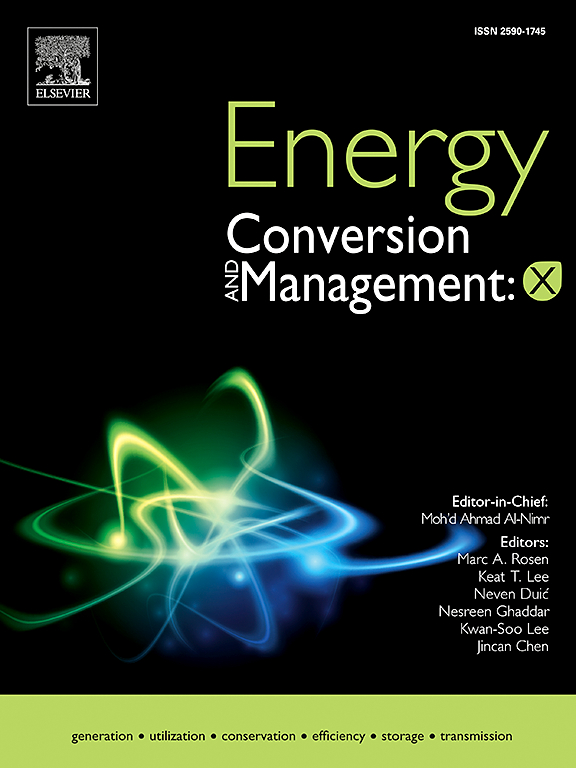氨热气氛压缩点火燃烧方式,实现高效燃烧和低温室气体排放
IF 9.9
1区 工程技术
Q1 ENERGY & FUELS
引用次数: 0
摘要
氨是一种广泛关注的无碳燃料,具有广阔的应用前景。国际海事组织认为氨是未来航运实现零碳排放的主要解决方案之一。已有研究表明,氨预混燃烧受火焰传播速度低的限制,燃烧效率低,氮氧化物排放量高,未燃氨排放量高。相比之下,混合控制扩散燃烧方式与氨高压直喷相比,可以显著提高燃烧性能,减少未燃烧氨的排放。因此,本研究创新性地提出了氨发动机的氨热气氛压缩点火燃烧方式,利用正庚烷预混燃烧产生的活性热气氛实现氨扩散燃烧。通过发动机实验、零维化学动力学分析和三维数值模拟等方法,对氨点火机理、氨扩散燃烧特性以及喷氨时机的影响进行了深入研究。实验结果表明,氨热气氛压缩点火燃烧模式具有良好的氮氧化物和未燃氨排放。通过控制喷氨时间,在不同的发动机负荷和转速条件下,观察到超低的氧化亚氮和未燃烧的氨排放。温室气体排放评估表明,该燃烧模式具有氨替代率高、氧化亚氮排放低的特点,具有很大的温室气体减排潜力。在调查条件下,最大温室气体减量超过70%,达到国际海事组织2040年温室气体减排目标。本文章由计算机程序翻译,如有差异,请以英文原文为准。
Ammonia thermal atmosphere compression ignition combustion mode to achieve efficient combustion and low greenhouse gas emissions
Ammonia is a carbon-free fuel with widespread attentions and broad application prospects. The International Maritime Organization considers ammonia one of the main solutions for achieving zero-carbon emissions in future shipping. Existing research indicate that ammonia premixed combustion is constrained by the low flame propagation speed, resulting in low combustion efficiency, high nitrogen oxides emissions, and high unburned ammonia emissions. In contrast, the mixing-controlled diffusion combustion mode with ammonia high-pressure direct-injection can significantly improve the combustion performance and reduce unburned ammonia emissions. Therefore, this study innovatively proposes the ammonia thermal atmosphere compression ignition combustion mode for ammonia engine, utilizing the active thermal atmosphere produced by n-heptane premixed combustion to achieve ammonia diffusion combustion. The ammonia ignition mechanism, ammonia diffusion combustion characteristics, and the influence of ammonia injection timing are investigated in-depth through engine experiment, zero-dimensional chemical kinetics analysis and three-dimensional numerical simulation methods. According to the experiment results, ammonia thermal atmosphere compression ignition combustion mode demonstrates favorable nitrogen oxides and unburned ammonia emissions. By controlling the ammonia injection timing, ultra-low nitrous oxide and unburned ammonia emissions are observed under various engine load and engine speed conditions. The assessment of greenhouse gas emissions indicates that the proposed combustion mode has great potential in greenhouse gas reduction thanks to the high ammonia substitution rate and low nitrous oxide emissions. The maximum greenhouse gas reduction under the investigated conditions exceeds 70 %, which meets the International Maritime Organization 2040 target of greenhouse gas reduction.
求助全文
通过发布文献求助,成功后即可免费获取论文全文。
去求助
来源期刊

Energy Conversion and Management
工程技术-力学
CiteScore
19.00
自引率
11.50%
发文量
1304
审稿时长
17 days
期刊介绍:
The journal Energy Conversion and Management provides a forum for publishing original contributions and comprehensive technical review articles of interdisciplinary and original research on all important energy topics.
The topics considered include energy generation, utilization, conversion, storage, transmission, conservation, management and sustainability. These topics typically involve various types of energy such as mechanical, thermal, nuclear, chemical, electromagnetic, magnetic and electric. These energy types cover all known energy resources, including renewable resources (e.g., solar, bio, hydro, wind, geothermal and ocean energy), fossil fuels and nuclear resources.
 求助内容:
求助内容: 应助结果提醒方式:
应助结果提醒方式:


